Part 1: Overview
Chinese history is long and complex—with records dating to around 1600 BC. Although the histories of Egypt and the Middle East are considerably older, cultural threads, exemplified in written language, architecture and other aspects of material culture, beliefs, and custom clearly link contemporary China to a distant past—more so than most contemporary cultures today. That cultural legacy has been at times a burden, but more often serves as a valued pool of philosophical, material, and spiritual traditions.
Part 2: Themes in Chinese History
Among the important themes that characterize Chinese history are the pattern of dynastic rise and fall, intermittent aggression from northern aliens, varying degrees of openness to outside cultural influences, and the dynamics of stability and social harmony. All of these themes still bear on China’s stance and position in the world today. Being aware of China's history and traditional culture will enable us to better understand events presently unfolding in the country.
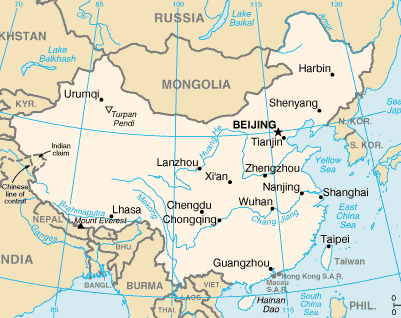
Map of China
Dynastic Rise and Fall
The Chinese record their own history as a succession of ruling dynasties that begins with the legendary Xia dynasty (2100-1600 BC), and ended in 1911-12 with the formation of the Republic of China—which was soon followed by the establishment of the People’s Republic of China in 1949. A dynasty is a succession of kings or emperors of the same family line. Although by the Qin dynasty (221 BC-207 BC) officials were appointed—eventually by participation in an examination system—the role of emperor was hereditary, in a succession that was ideally father to son. In many cases, however, other relatives, and on a few occasions even non-blood relatives, occupied the throne. Although Chinese history is regarded as a succession of dynasties, during certain parts of Chinese history the land area we call China today was under the control of a number of different kingdoms. After the fall of the great Han dynasty around 220 AD, China fell apart into many smaller kingdoms, and was only reunited over three hundred years later by the short, but powerful Sui dynasty (580-618 AD). During the Song dynasty (960-1279 AD), invading tribes set up the Jin and Liao kingdoms in northeast China, and a large kingdom of Tibetan-related peoples called Xixia existed in western China. Therefore, when thinking about Chinese history, it is important to imagine it as a complex picture of unity and disunity over a very long time span.
In a general sense, there was a pattern of dynastic rise and fall, often reflected in historical accounts, poetry, and other literature of China. According to the pattern, a dynasty is 1) founded by force during a period of disorder; 2) vigorous rulers create a stable, prosperous state that secures or extends the borders; 3) after a period of success and stability (which often entails population growth), leadership declines, wealth concentrates into fewer hands, and the population outstrips resources; 4) the dynasty collapses due to internal uprisings—sometimes coupled with foreign invasions; 5) after a period of weakness and disunion, the cycle starts again with dynamic leadership (sometimes foreign, as in the case of the Mongols and Manchus), often in a climate of lowered population and redistributed wealth.
This theme of dynastic rise and fall resonates especially strongly in the Han, Tang, Song, Ming, and Qing dynasties. Many poets used allusions to patterns and events in past dynasties to comment on situations in their own times. Even today modern Chinese look back on their history as they attempt to make sense of their emerging nation.
Aggression from Northern Aliens and Other Non-Han States
Relations, often antagonistic, between nomadic Turkic and Mongol peoples of the northern steppes and forests and the settled agriculturalists of the North China Plain go back far into antiquity. Among the northern invaders were the Xiongnu and Xianbei, who were followed in later centuries by the Qidan (Khitan), Jurched, Mongol, Turk, and Manchu (Manju) peoples. During periods of division, small states appeared and disappeared in northern China on the borders with the steppes. This was especially so between the Han and Tang dynasties. During this time many such states had Creole-cultures that combined steppe and sedentary cultures. Among these peoples were a group known as the Toba, whose descendants were among the founders of the great Tang dynasty.
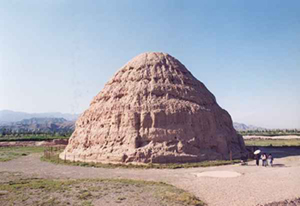
Xixia Tomb
Besides the northern steppes and northeastern forests, alien states existed at times in other border areas. Among these were the Tibetan empire in the west, the Nanzhao in the southwest, the Tangut (Xixia) empire of the northwest (in present-day Ningxia), and the Uygur kingdom farther to the north in Xinjiang. Many smaller kingdoms existed as well, including the little-known Parhae kingdom located in parts of present-day northeast China and North Korea.

Wang Zhaojun with pipa
Nomads on the northern steppe depended on trade with the agriculturalists for grain, cloth, metal tools, ceramics, and other items. In turn the agricultural peoples desired promises of peace from raiding parties, and demanded tribute in the form of horses, furs, gems, and other rarities from the steppe and forest nomads. In the course of diplomatic negotiations, Chinese states sometimes sent beautiful brides to far-off “barbarian” rulers on the steppe. One of the most famous was Wang Zhaojun of the Han dynasty, who lived many years among the Xiongnu. Her tomb mound lies near the city of Hohhot, Inner Mongolia.
In some cases, Chinese rulers attempted to play rival groups of “barbarians” against each other; at other times, the border peoples created alliances to attack China. When the Mongols invaded China they had to defeat the Jin, who had already conquered the northern part of the Song dynasty, as well as the Xixia kingdom in the northwest.
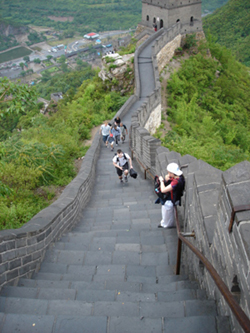
The Great Wall near Beijing
At certain moments the nomadic peoples feared the strong Chinese armies, at other times the steppe people offered great enough challenges to the Chinese to stimulate the building of walls on the northern frontiers – culminating in the greatest “Star Wars” project of antiquity: the Great Wall. The wall, actually a series of smaller walls, reached its most advanced state during the Ming dynasty after the Mongols were driven from China.
Degree of Openness to the Outside
Due to its geographical location, China could limit contact with the outside world. Aside from the northern nomads (who were not a cultural threat to the Chinese), the deserts and mountains of the west and the oceans of the east allowed the Central Kingdom relative (and often peaceful) insulation from entities such as the Roman Empire, which was at its height during the Han dynasty. The Silk Road was a narrow thread across the northwest barrens that allowed a limited but steady flow of goods and ideas across Central Asia between the high cultures of the Mediterranean, the Middle East, and India. During the Tang period, China was at its most open stance in antiquity. Elements from the cultures of the West, particularly India, were welcomed and took root within China’s borders.
After the Mongol invasions of the 13th centuries, China was for the first time under complete foreign control. When the Mongols were finally driven out in the mid-14th century, the rulers of the new Ming dynasty were more wary of foreign influences than emperors in the Tang period. By the mid-15th century the Chinese had made voyages to the coast of Africa, but in an inward turn the Chinese ships of exploration were ordered burned by the emperor and the Great Wall was refurbished.
As China began to lose ground technologically to the West, the Manchus invaded in 1644. Less than a century later, the British were warring with China over rights to peddle opium within China. By the turn of the 19th century, China was in danger of being cut to pieces by Western and Japanese imperialists. Over the centuries, ambivalence towards foreign contact developed. By the late 19th and early 20th centuries the principle of “taking what is best” from the outside was developed in an effort to import positive things from the West while keeping out influences thought to weaken or humiliate China.
The most recent expression of this open/shut dynamic was the near closing of mainland China to much of the outside world between 1949 and the late 1970s. Feelings derived from negative experiences with foreign contact still linger under the surface in China today.
Concerns of Government Stability
As explained in more detail in Module Three, social harmony was a key component of the ideas of Confucian statecraft. If rulers and subjects alike acted in proper accord with their positions, all would be well with the realm. It was up to the ruler to set the example by behaving properly so as to preserve the supernatural permission —or right to rule—known as the Mandate of Heaven. If a ruler was out of sync with the heavens, then chaos in society was sure to follow. What was feared most in this ideal system was instability and chaos. Instability was the result of any number of factors, including famine, invasion, unfair conscription of laborers and troops, over-taxation, and incompetent, corrupt, or malicious rulers. When conditions become unstable, popular uprisings can result that may prove difficult or impossible to quell.
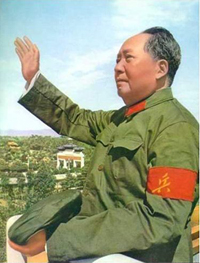
Mao Zedong
According to legend, the empire of China’s first emperor, Qin Shi Huangdi, was brought down by a popular rebellion ignited by a group of workers on the Great Wall. Delayed because of a rainstorm, they were sentenced to death – but chose rebellion instead. In the first half of the 20th century, popular uprisings lead by Sun Yat-sen’s Nationalist Party brought down the Manchu government. Not long after, other popular forces, led by the Communists, took advantage of chaos within China caused by a weak central government, local warlords, and foreign invasion, to bring their movement to power over most of the territory in 1949. During the rule of Chairman Mao Zedong, particularly from 1966 to 1976, young minds and emotions were whipped into widespread chaos that endangered the vitality of the state. Today, with an eye to the past, Chinese leaders must consider the effects of their policies in terms of state stability.
Part 3: Prehistoric Era
Prehistory
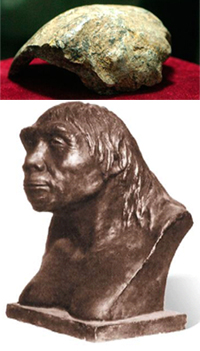
Peking Man's fossil skull and possible appearance
Evidence of early hominids has been found on a number of archaeological sites in northern and southern China. The most famous of these is the so-called “Peking man” (once labeled Sinanthropus pekinensis), who seems to be a variation of Homo erectus, a widespread hominid who lived between one million and 250,000 years ago. Besides Peking Man (now called “Beijing Man”), similar fossils were found near Lantian in Shaanxi and near the city of Liuzhou, in the mountains of Guangxi. A number of sites with stone tools from early Homo sapiens have also been discovered in northern China, though the exact relation between these early modern humans and the Chinese people is still being examined.

Liujiang Man's fossil skull, found in Liuzhou
Neolithic, or “New Stone Age,” cultures featuring early forms of agriculture, weaving, advanced stone tool technology, village organization, and ceramics date to at least 6,000 BC in China.
The best-known sites are from northern China in the Yellow river drainage and include the famous “Banpo Village” site near the ancient city of Chang’an (modern Xi’an). The village was surrounded by a protective ditch which enclosed a number of round-shaped earthen pit dwellings and a pottery making center.
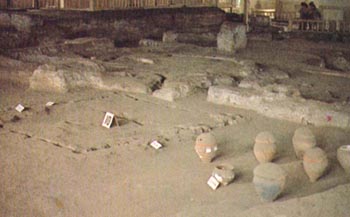
Banpo Village
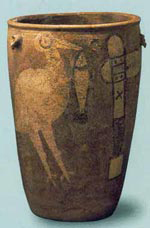
Yangshao Pottery
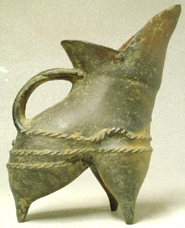
Longshan Pottery
Myth and Legend
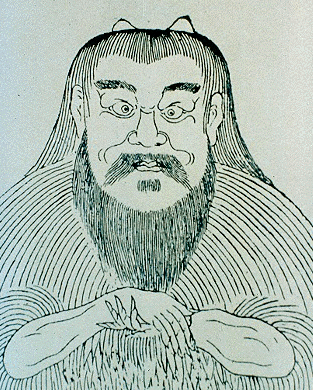
Pan Gu
Each cultural area in East Asia has mythical accounts of the creation of heaven and earth, human beings, and civilization. Records of Chinese creation myths date to the Han dynasty (though certain elements may be much earlier). According to the accounts, in the earliest times there was undifferentiated murkiness. As things progressed, the light-weight substances rose and the heavy settled, resulting in the heavens and earth. The body of an early being, Pan Gu, metamorphosed into a myriad of things, and thus the earth gained geographical features and was populated with plants and animals.
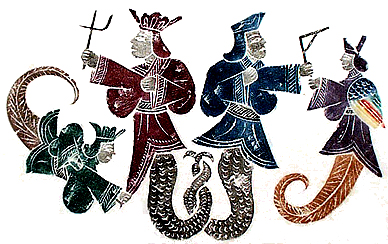
Nu Wa and Fu Xi, holding a gui (compass) and a ju (square)
Among the early beings were the male Fuxi and the female Nuwa. Nuwa created the first humans out of clay and Fuxi is said to be an early ruler. Other early rulers followed, including Shen Nong, who invented agriculture and, the Yellow Emperor, who invented pottery and the civilizing technology of writing.
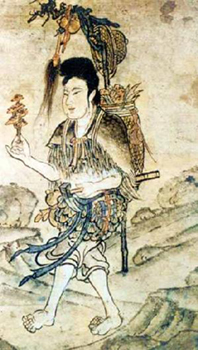
Shen Nong tested hundreds of kinds of herbs
The early rulers Yao and Shun were regarded as model emperors because of their dedication to proper principles of succession and governing – with an emphasis on good leadership. Their successor was Yu, who is said to be the founder of the legendary Xia dynasty, supposedly founded in 2205 BC. Records from the Shang dynasty and archeological evidence suggest that Xia may have actually existed on the North China Plain, although teams of archaeologists have been searching for its remains for decades. No conclusive findings have been made, though Xia and Shang may have both been related to earlier Yangshao and Longshan cultures.
Part 4: Early Feudal Era
Shang Dynasty (1600-1100 BC)

Tomb sites found in Anyang
Like the Xia, the Shang dynasty was known only from historical records, until archaeologists uncovered ruins and tombs of the ancient Shang capital near Anyang in northern Henan province in 1927. Found also were over 100,000 animal scapulae and tortoise shells engraved with around 3,000 different written characters in the so-called oracle bone script. These are the oldest documented examples of fully-developed Chinese writing.
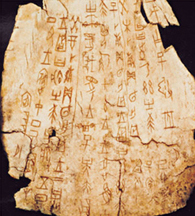
Jiagu wen (oracle bone script), found in Anyang
Historians today feel that the Shang culture was likely similar to the earlier Xia kingdom and centered on dynasties of kings who presided over rituals and ruled over villages of peasant farmers. Remains of large tombs, and altars made using rammed earth technology (walls and foundations made by ramming wet earth within large molds – a practice still used to make adobe dwellings in parts of China today), indicate a high degree of social organization was needed to produce these structures.

An bronze vessel with a "tao-tieh" design, found near Anyang
Writings from the Han dynasty indicate that there were 30 Shang kings, and that succession was passed from elder to younger brothers as well as from father to son. Shang beliefs seem to have centered on ancestral spirits and a god known in the records as Shangdi, or “upper ruler.” The ruler was thought to have direct links to the powers on high. Rulers presided over a number of ministers who helped direct affairs of the palace, the realm, and ritual, as well as ranks of civil and military officials. Although rulers were typically male, Fu Hao, the wife of one ruler, is said to have been one of Shang’s most able military generals.
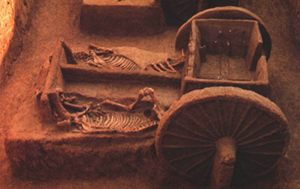
A chariot and horse skeletons, found in Anyang
The tombs at Anyang indicate that sacrifice to the heavens and ancestors were an important part of Shang ritual life. Among the grave goods are sophisticated bronze ritual vessels, skillfully cast in clay molds using techniques first developed for pottery production. A common artistic motif on the bronzes was the “glutton” or “tao-tieh”—a kind of supernatural beast with gaping jaws (see the design in the photo above). Offerings of food and drink were placed in these vessels during rituals. Many remains of human sacrifices have also been uncovered from the tombs at Anyang, including a few skulls with more Western features. Chariots uncovered in the tombs suggest at least indirect contact with Mesopotamian cultures.
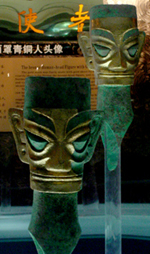
Bronze heads with masks of bronze and gold found in Sanxingdui
In recent years Chinese archaeologists have uncovered a number of other early sites in southwest China. The Sanxingdui (Three Stars Cache) site near Chengdu, the capital of Sichuan province, may be contemporary with Shang. The site is noted for is large assemblages of bronze objects–quite unlike those found in Shang. Of particular note are hundreds of stylized bronze heads – many broken – and existing in various sizes. Most outstanding is an abstract, life-size image of what seems to be a ritual specialist. The findings at Sanxingdui and nearby sites raise more questions about early cultures in China than they answer. But one thing is clear. As research continues, a fuller picture of the early origins of Chinese culture will emerge.
Zhou Dynasty (1100-221 BC)
The Shang dynasty gave way to another kingdom called Zhou in 1100 BC. The Zhou were once part of the Shang realm, and were located on the northwest borders near present-day Xi’an. Referred to as “barbarians” in early accounts, the Zhou seem to have conquered the Shang with a force of only 50,000, after armies of the degenerate and oppressive Shang king joined the invading forces. Early rulers included King Wen (the “Cultivated”), who helped lay the foundation for the Zhou victory, and his son King Wu (the “Martial”), who carried it out. These two rulers embodied dual aspects of Chinese leadership incorporating both civil and martial strengths that would remain relevant for centuries.
Once Shang resistance was squelched by King Wu, a new order was put in place that evolved into a feudal system in which a central Zhou state developed relationships (by blood or marriage) with local lords all over the former Shang realm. Military prowess and accomplishment remained important attributes among the upper classes. Most people were farmers, and therefore serfs to various levels of local lords. There were also classes of craftsmen and traders.
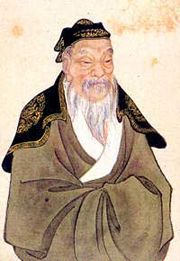
Duke of Zhou
The early period of conquest and rule, called the Western Zhou, produced another exemplary leader named the Duke of Zhou. The Duke was instrumental in forming an efficient bureaucratic state and later in the Zhou period, the sage Kongzi (Confucius) held him in high regard for his proper conduct. According to the story, the Duke of Zhou was the brother of King Wu and upon Wu’s death was made regent for his son. After years of giving good advice and guidance to the future heir to the throne, the Duke of Zhou “did the right thing” and stepped aside when the young king was ready to assume power. Although he probably could have wrested the kingship for his own, the Duke of Zhou demonstrated that proper conduct (li) and virtue (de) were more important than personal ambition.
By 771 BC the Western Zhou had weakened due to natural disaster and ineffective leadership, finally collapsing under pressure from combined forces of western nomads and native Chinese. A popular legend tells that the last Western Zhou King would light signal fires to entertain his favorite concubine. In something like the “boy who cried ‘wolf’” story, he lit them one too many times, and the western part of the realm was over-run.
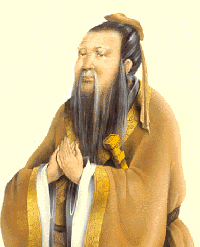
Kongzi (Confucius)
Under a new king, Zhou forces reconstituted themselves in the eastern capital called Luoyang, in present day Henan province. One era of the new Eastern Zhou dynasty was known as the “Spring and Autumn” period (770-476 BC), famous for literature and rich philosophy, including the “Hundred Schools of Thought.” Confucianism, Daoism, Moism, the Yin-Yang School, and many other philosophies flourished in this period. Classic writings and compilations like the Daoist classic, the Daodejing, the Analects of Confucius, the Book of Songs, and Sunzi’s Art of War all date to this period. This was an age of cultural and philosophical development that later ages would see as the true cradle of Chinese civilization.
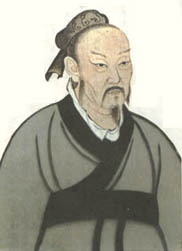
Mengzi (Mencius)
An important idea in Chinese statecraft that had evolved early in the Zhou era was refined in this period. Thinkers such as Mencius (Mengzi) explained that under the so-called “Mandate of Heaven” only good rulers could receive the mandate (permission) of heaven to rule. If a ruler acted in accord to the will of heaven, he would then remain in power and continue to serve for the benefit of the realm. If he failed in his duty, then the mandate would be withdrawn, and another ruler would come to power. Implicit in this formula was the peasant’s right to rebel if life became too intolerable. Under this theory, the early Zhou rulers legitimized their usurping of the Shang. In later ages, the theory would be invoked many times to justify government takeovers in China. The social structure also underwent change. The Zhou kings were weak and many local states were nearly independent powers. Social mobility was also greater, and the influence of powerful families closely related by blood to the rulers declined. Changes in land tenure changed as well, with peasants paying taxes (rather than just labor) to their lords and the development of freer exchange of land. Metal coins became widespread in an economy that involved extensive and increasingly complex trade networks. Technological innovations saw the increased use of cast iron in place of bronze, allowing for advances in mass production of farm implements and weapons—resources that would come into play in the final era of the Zhou dynasty.

Warring States bronze weapon: ge with beast face pattern
This last era was known as the “Warring States” period (475-221 BC). During this time, the individual Zhou states (which had their own armies) began full-scale struggles for power to rule and strategically ate each other up. By the end, only three states (Chu, Qi, and Qin) remained out of an original total of about seventy. The winning state was Qin. Located in the northwest, near the old Zhou homeland, the Qin had experimented with the principles of Legalism (fajia), which were promoted by the philosopher Han Feizi (d. 233 BC). Unlike the program of Confucius, Legalism distrusted human goodness, and relied instead on bureaucratic theories of organization enforced by strict codes of rewards and punishments. With the final collapse of the Zhou feudal system, Legalist principles were implemented in the establishment of a unified empire under the leadership of China’s first emperor, Qinshi Huangdi.
Qin Dynasty (221 BC-207 BC)
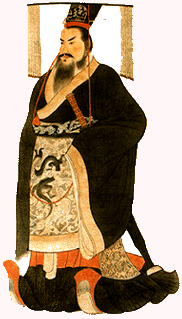
Qin Shi Huangdi
Although the Qin is the shortest of the major Chinese dynasties, it marks a transition point between the weak-centered feudal states of the Zhou era and the emperor-centered imperial states of succeeding dynasties. Innovations in the Qin laid the foundation for government structures that lasted, with some modification, down into the early 20th century, ending with the collapse of the Qing dynasty in 1911-12, 2,000 years later.
When the forces of Qinshi Huangdi, under the guidance of the Legalist thinker Li Si, took control of the Zhou territories, methods were employed to secure control over the realm. Setting himself up as an all-powerful emperor, Qinshi Huangdi’s power was absolute. Hereditary blood-ties were no longer a part of officialdom, and each position in the newly-created state bureaucracy could be filled as if moving individual pieces on a chess board. Local officials were strategically placed in areas where they had no local allies, requiring them to look to the emperor for support. Weights, measures, and written characters (which at the time had many local variants) were also standardized so that officials in all parts of the land could easily read all documents. The widths of cart axles were also standardized so that any cart could run on any of the earthen roads throughout the land, thus increasing the speed and efficiency of transport and taxation. The old states were re-divided into provinces and prefectures until the control of appointed officials, while the ruling families (those that survived) were ordered to the capital to deprive them of power.
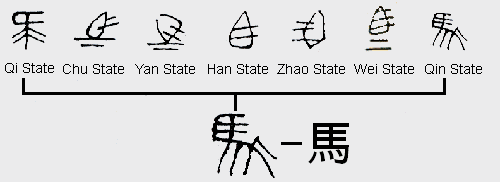
Different characters for the word "horse" were standardized in the Qin period. The one on the bottom right is the standardized character of today.
Other attempts at control included the burning of all but one copy of each of the Confucian writings (213 BC). Though books on technical subjects were spared, more books were lost in the chaos at the end of the dynasty. Thus, much of the early learning was lost, though after the emperor’s death many books were recovered from surviving scholars who had memorized them by heart. Legend also says the emperor ordered several hundred Confucian scholars, seen as subversive to the new order, to be buried alive. Many other stories exist of the cruelty and excess of Emperor Qin.

Early Great Wall in today's Hebei Province
Hundreds of thousands of farmers were conscripted to work on public works projects, the most ambitious project being a series of walls across the northern frontiers. The tale of Meng Jiangnu, who searches for her husband’s bones along the Great Wall, is one of China’s most enduring folk tales. Conscripted labor also built a massive tomb near the modern city of Xi’an. Five huge armies of life-size terra-cotta warriors and horses were arranged around the tomb to guard the emperor in death. The tomb itself has yet to be opened by Chinese archaeologists, who wish to perfect their techniques before attempting to excavate a structure that legend says contains a detailed model of heaven and earth, complete with jeweled skies and mercury lakes. After the discovery of the terra-cotta armies in the late 1970s, a huge museum complex has been opened to the public, where hundreds of thousands of visitors can view the excavated remains of China’s first great empire.
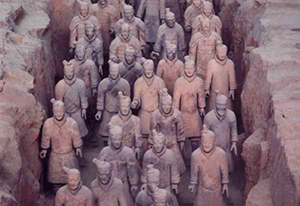
Terra-cotta warriors found in the Qin Emperor's tomb
That empire came to an end soon after the emperor died while on a tour. Legend says that his decaying body was covered with fish on the journey home so that news of his death would not spread. Uprising and rebellion soon followed however, and none of his weak, young successors were able to hold onto power. This ultimately ushered in the rise of the great Han dynasty—China’s first long-lasting empire, based on many of the principles developed during the Qin.
Han Dynasty (206 BC-220 AD)
The majority ethnic group in China today is called the “Han nationality.” The name derives from the first great empire that lasted over four hundred years at about the same time as the Roman Empire (though the two states knew very little about each other’s existence). The Han empire was founded in the chaos after the fall of the Qin by a rebel leader known as Liu Bang, or by his reign name (given after his death), Han Gaozu (Kao Tsu). The early years of the Han were ones of consolidation of power.
At the start, power was shared to some degree with local kings, but as time went on and the bureaucracy was revitalized along lines similar to the Qin, the emperor’s power grew. Legalist theory was also gradually replaced by a re-vitalization of Confucianism. This eventually resulted in the strengthening of the role of the “Son of Heaven” and in a more moderate state in terms of what we would call “human rights.” Social classes included the ruling imperial family, civil bureaucrats, landed gentry (who acted as small-scale local powers), farmers, artisans and craftsmen, and merchants.
Great advances were made in intensive agriculture, including crop rotation, fertilizers, and new techniques in the use of draft animals. Town and country were linked in a more advanced agrarian economy, and many farmers had sideline activities such as textile production. There were also attempts (not always successful) to keep tax burdens on peasants low. This was done in part by creating state monopolies on high-consumption essentials such as salt, iron, and alcohol in order to temper the growing economic wealth of the merchant-class. Graves of the Han dynasty gentry class offer a wealth of insights into everyday life, as scale clay models of everything from prosperous houses, to ample kitchens, to well-stocked courtyards, to nursing farm animals were interred with the dead. The borders of the Han grew, with advances along the Silk Road towards Central Asia, and large scale migrations into southern China.
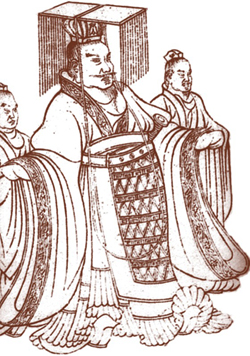
Han Emperor Wu Di
After the founders, the greatest Han emperor was Wu Di (Wu Ti), who reigned from 141-87 BC. The role of the emperor as a model of virtue who worked for the good of the people was expanded under his reign. Confucian philosophy also advanced, including the idea offered by Dong Zhongshu that nature would give signs such as earthquakes or floods if a ruler was losing the “Mandate of Heaven,” and speculated on the inter-relations between the heavens, earth, and mankind. In 124 BC, an examination system was set up that offered an opportunity to males of any respectable background to elevate their (and their family’s) positions in life. It also served as a way to get true talent into the system. Much of what we know about early Chinese history comes from the writings of the historian Si Maqian (died c. 85 BC), who dedicated his life despite being castrated for displeasing the emperor to researching and editing the surviving writings of the past. Buddhism arrived from India by the first century BC and gradually grew in popularity.
Throughout the Han era the Xiongnu on the northern borders were a threat dealt with first by warfare and then by a policy of diplomacy and appeasement that included Chinese brides. Under Wu Di, the borders were expanded in a series of wars against the Xiongnu and command posts were established on the Korean peninsula in 108 BC.
As time went on, however, the wars with the Xiongnu and other border peoples grew costly, lifestyles at the court grew lavish, and the tax burdens on the populace increased. After Wu Di’s death, attempts were made to rectify the situation, but eventually a usurper named Wang Mang came to power. He was the nephew of Empress Wang — one of a number of women who held powerful, but temporary positions during the Han.
Once Wang Mang took over the throne and attempted to institute social reforms by taking from the rich and giving to the poor. His reforms included the re-division of landholdings, freeing of slaves, social welfare and revolving credit programs for the poor and farmers, taxes on the use of firewood and natural resources, and reinstitution of government monopolies on certain goods. In practice, most of the reforms were not effectively instituted, or had the effect of adding even greater economic pressures on the populace. He also launched costly, disastrous campaigns against the Xiongnu.
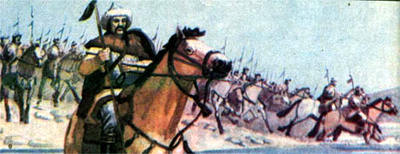
Xiongnu invaders crossing a river
Eventually both the upper-class gentry and the greater population vehemently opposed the attempted reforms. As the young government de-stabilized (possibly due in part to a traumatic shift in the course of the Yellow River in northern China), popular revolts led by the Red Eyebrows brought the death of Wang Mang and an end to his experimental rule. The historian Wolfram Eberhard notes that Wang was decapitated while reading ancient scriptures in his chambers, and his skull preserved for two hundred years.
After Wang’s death, the Han dynasty was revived by surviving members of the Han imperial line and returned to its former glory, though the capital in Chang’an (modern Xi’an) was moved eastwards to Luoyang. By about 189, however, the realm was again on the road to crisis and collapse. Wars with border peoples like the Xiongnu and Xianbei, internal problems with powerful military cliques, weakening leadership in the imperial court, and more popular revolts – this time by the Yellow Turbans and other groups— finally weakened the dynasty, which collapsed in 220 AD, ushering in a period of in which China was in a state of disunion for about three hundred years. As Professor J.A.G. Roberts has observed, Rome fell at nearly the same time – and for similar reasons (especially pressure from nomadic peoples) – though Europe was never reunited in the same way again.
Period of Disunion and Alien Empires(220-581 AD)
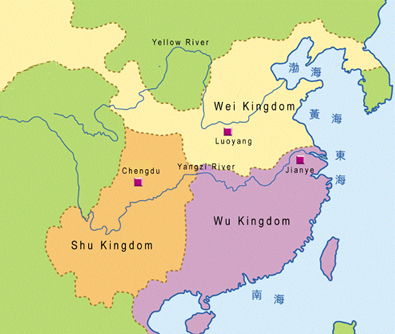
Map of the Three Kingdoms
With the fall of the great Han dynasty, the Middle Kingdom ceased to exist. For the next three and a half centuries numerous small kingdoms rose and fell on the lands that were once all Han. First among these were three kingdoms, two southern ones called Shu Han (in present-day Sichuan) and Wu (in the Yangzi basin), and a northern one called Wei. Battles and intrigues between the rulers of these states constitute the plot of China’s greatest historical romance, The Romance of the Three Kingdoms (Sanguo yanyi). The northern Wei state had a population of about 29,000,000, making it by far the largest state. Among its population were 19 groups of Xiongnu who had been allowed to settle in China near the end of the Han. There was relatively little encroachment on the northern frontier at first, since alliances among the nomadic tribes themselves had recently fallen apart, and were yet to be reunited under a charismatic leader. During this period the Wei actually forged an alliance with the early Yamato state in Japan to attack hostile nomad groups on the Korean peninsula.
As time went on, these kingdoms collapsed and large numbers of demobilized Chinese soldiers began farming and offering various trades on the northern borders. In turn nomads of Turkish, Xiongnu, Xianbei, Tibetan and other ethnic backgrounds allied and took control of adjacent areas. Cultures interacted over time, and a series of small states rose and fell. Some attempted to follow Chinese models of rule, many others gave their loyalties to charismatic rulers (a nomad attitude) whose kingdoms fell apart at their deaths.
During the fourth century a Tibetan leader created a large domain in western China. This was followed later in that century by a large state that ruled northern China and contiguous areas into the mid-sixth century. The state was a multi-ethnic federation populated by the Toba people, whose leaders had adopted many aspects of Chinese tradition.
In the south there were fewer kingdoms, although cultural mixing between ethnic Chinese and southern aboriginal peoples also took place. Northern immigrants were forced to adopt diets less rich in meat and higher in soybeans, fruits, and leafy vegetables as well as adopt southern techniques of wet rice farming instead of the dry-land wheat production of the north. In some instances, even the southern regions were subject to raids from the northern nomads.
Written records of the period of disunion are mostly from Chinese language sources—often written by intellectuals at the service of “barbarian” overlords. The most important intellectual and spiritual trend of the long era was that of Buddhism and monks continued to enter the Chinese regions on both northern and southern trade routes.
Part 5: The Great Dynasties
Sui Dynasty (580-618 AD)
China was finally reunited under the efforts of a capable and thrifty military leader from the northwest named Yang Jian, also known by the reign title, Wen Di. His dynasty would be known as Sui. Like the earlier Qin dynasty, however, the Sui was short and severe, but garnered many accomplishments.
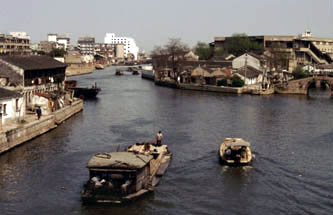
Today's Grand Canal
The Sui revitalized old connections throughout the empire and revived institutions of control that would be further embellished by the great Tang dynasty that followed. Among the accomplishments of the Sui was the building of the Grand Canal that linked the thriving cultures of southern China with those of the north, near his new capital at Luoyang. The canal acted as an inland watery highway, especially useful for the transport of grain.
Strains were placed upon the Sui treasury by wars with alien peoples on the northeast border, including attempts to defuse an alliance between the Korean state of Koguryo and nomadic Turkic allies. Leadership also became a problem after Yang Jian’s son, Yang Guang, or known by his reign title, Yang Di, took the throne. Although he is responsible for the success of the Grand Canal, historians and popular literature have not been kind to his memory. A case study in imperial decadence, the emperor was known for high living and lavish expenditures on parties, palaces, and lengthy trips through the exotic southern reaches of his realm.
Stories of Yang Di’s well-known “pleasure tour” throughout the lower Yangzi delta are still told by storytellers in China today, and became the subject of racy vernacular romances by the 17th century. Legend suggests that he had the custom of being drawn through the streets in a carriage pulled by unclad young men and women, who would unceremoniously topple upon each other when the ruler pulled back on the reins.
Losing support of the gentry landholders, the Sui economy eventually waffled and uprisings began. Retreating to the south, Yang Di was eventually assassinated (at the hand of his most trusted general’s son, while bathing) in 618 AD and the empire was again dissolved. In the meantime, however, a capable general named Li Yuan and his brilliant, but ruthless son, Li Shimin had managed to position themselves for conquest and rule of their own dynasty—the Tang.
Tang Dynasty (618-906 AD)
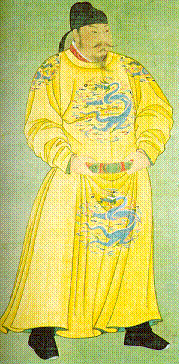
Emperor Taizong, Li Shimin
Chinese historians regard the Tang dynasty as both a revival of the best of the Han dynasty and the high point of power and culture in Chinese history. An open, cosmopolitan era, the Tang was a time when cultural influences and ideas streamed into China on the Silk Road, and China became a model for emerging kingdoms in Korea and Japan. Its capital, Chang’an at times had a million inhabitants and drew peoples of many faiths and ethnicities from all over the accessible world. Art and literature flourished in the Tang period, and it was the peak moment of Chinese lyric poetry.
Li Yuan, a military leader of possible Toba background founded the Tang. Allied for a period with threatening Turkish nomads, he and his son Li Shimin, toppled the weak Sui government and ruthlessly took control. In the process, Li Shimin killed his elder brothers who were conspiring against him), as well as many other rivals. Once assuming control Li Shimin, also known as Tai Zong, went on to become one of the most effective emperors in Chinese history, leading a strong, stable, and influential state.

Tang pottery in Shanghai museum: Westerner on camel
The walled capital of Chang’an (modern Xi’an) was a bustling city filled with foreign merchants who arrived on the Silk Road, though the sometimes capital of Luoyang was still an important city. Chang’an was divided into over 100 districts, including those for pleasure and living quarters of the foreign merchants—which included Turks, Sogdians, Indians, Jews, Manicheans, Zoroastrians, and Nestorian Christians. Music and dancing from Central Asia were popular in the pleasure quarters—often performed by exotic foreign women. Such areas were frequented by scholars and officials and are described in the poetry and literature of the era. Markets were filled with exotic fruits including grapes, melons, and lichee nuts (brought by “pony express” from southern China). Silks, damasks, satins, jade, agate, coral, pearls, rubies, rare woods, furs, and precious metals were all traded in and out of the city. Southern ports in far-away Guangdong welcomed traders from countries all around the Indian Ocean and Southeast Asia, including Arab and Persian traders from the Middle East.
The civil and military bureaucracies were revived and expanded under the Tang. Below the emperor were civil officials and military leaders, largely drawn from powerful gentry (large, hereditary landowners) families. Middle-level positions were filled by men from provincial gentry families and those who did well in the civil service examinations that were reinstituted in the Tang. The greater populace was comprised of farmers, artisans, craftsmen, and traders. Large armies were deployed on the northern borders and local armies and militias were filled with peasant farmers.
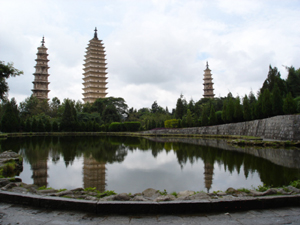
Three white pagodas in today's Dali, once the Nanzhao Kingdom's capital
Military campaigns were carried out against Turks in the northwest and eventually against Korean states in the east, Tang forming a special relationship with the kingdom of Shilla. Chinese influence on Japan (in the Nara and Heian periods) was also great at this time. On other fronts, in the seventh century the Tibetan state became very powerful to the west, and a large kingdom called Nanzhao arose in what is now southwest China and parts of Southeast Asia.
Land was an issue from the very beginning in the Tang. Among the first acts of the new rulers were attempts at land reform. In an attempt to weaken the holdings of powerful gentry landholders, land was re-divided, giving farmers equal shares of land – a system that had been tried in earlier times, including Wang Meng’s experiments in the Han and for a while in the Toba kingdom. This “equal field” system offered both advantages (land to till) and disadvantages (taxes and corvee labor) to the peasants. Over time, many moved to the less-restricted south, eroding the tax base. Another old system called “baojia” (collective households) was tried. In this system, the farmfolk were divided into five family groups responsible for submitting their taxes and annual labor quotas (for state projects). Even this proved ineffective, and the attempts at land reform gradually diminished as the gentry regained power over more lands.
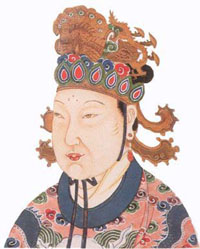
Empress Wu Zetian
A number of colorful rulers and other palace figures populate Tang history. Among these is Empress Wu Zetian, arguably the most powerful woman in Chinese history. She came to the imperial court as a concubine of Li Shimin, but later had a relationship with his son, Emperor Kao Zong. She eventually became his empress (forcing him to divorce his wife), and succeeded in placing her son on the throne. She later deposed him and placed herself in power as emperor of her own Zhou Dynasty, which lasted form 690-701. According to Wolfram Eberhard, this was in part possible because women in the Tang had more freedom of movement than in earlier and later times due to lingering attitudes from the nomad kingdoms in the period of disunity. Once in control, Wu Zetian, in an attempt to consolidate her power, moved the capital east to Luoyang, away from the powerful gentry families of Chang’an. She instituted reforms in the examination system and government – making it more difficult to succeed solely on family connections and women were allowed to take civil service examinations to become officers in the court. She also promoted the interests of her allies, the Buddhists. Many monasteries became very rich. Huge temples and a massive iron pagoda were built with government support. A good administrator, the country was strong under her rule, though in constant threat from the Turks. Nevertheless, historians have been unkind to Empress Wu, traditionally describing her as evil and debauched. In recent years, her accomplishments have begun to be better appreciated.

Painting by Wang Xuyang: peasant rebellion lead by Huang Chao at the end of the Tang Dynasty
Empress Wu was eventually forced from power and the Tang was restored. Soon after, the Emperor Xuanzong came to power. He was a capable ruler who fortified China’s northern borders by the establishment of nine military command zones staffed by his appointees. He also made reforms in government administration, finances, and attempted to deal with problems of grain transport and taxation of the peasants. In his later years, however he became infatuated with a young concubine Yang Guifei. Their love affair is one of the most popular tragic love stories in China. During this period, one of the border commanders, a man of mixed-nomad stock named An Lushan, ingratiated himself with Yang Guifei and later fomented a rebellion that ended in 763 and marks the decline of Tang power. Although Tang was still in many ways a well-run state, after the An Lushan rebellion, a crisis in leadership ensued. The borders weakened, as did the imperial treasury, and rebellions ensued. Eventually smaller military states began to appear in north China. Eventually Tang fell apart, ending a great period of openness, creativity, and power.
Second Period of Disunion (906-960 AD)
The decades after the fall of the Tang dynasty are known as the Five Dynasties and Ten Kingdoms, referring to a succession of small states. It was a time of division between north and south and of rapidly changing administrations. By 960 AD, China was again reunited in the Song dynasty.
Part 6: Shift towards "Modern times"
Song Dynasty (960- 1279 AD)
The Song marked a period of transition in more “modern” forms of society as many of the powerful gentry families of the Tang period crumbled and a new era of social mobility for males of all classes began. The new leaders brought the military under control and strengthened the civil side of the government with modifications in the civil service examinations. As J.A.G. Roberts has noted, the society was becoming more a meritocracy, with less emphasis on family background.
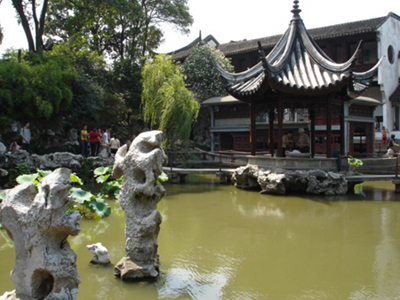
Chinese garden architecture in the Yangzi delta
As described in Module One, development of new styles of urban life was associated with a growing middle-class due in large part to an increasingly sophisticated economic system that allowed the growth of merchant guilds and revived the use of money (which had declined in the previous eras). In part, this development was due to a shift in focus to the Yangzi delta, which had been growing in population for centuries and had been made more accessible due to the canal links to the north. The delta cities of Hangzhou, Suzhou, and Yangzhou all became important economic and cultural centers, and today offer some of the finest examples of Chinese garden architecture in existence. Scholars in these cities advanced the arts of landscape painting and poetry during this period. Many technological advances also occurred in the Song, including the widespread introduction of printing, advanced military devices employing gunpowder, irrigation techniques, watermills, and so forth.
One less “modern” change was the increased restrictions on the activities of women within and without the home. Widows, for instance, were discouraged from re-marrying. Although many women were engaged in household textile production, they were seldom allowed to leave the home except for occasional visits to temples or to attend certain festivals. The relative freedoms of the Period of Disunion and the Tang were replaced by a stricter system of clan and household management that gave more power to male heads. Neo-Confucianism, which developed in the Song, served in part to define women’s roles in society.
Although in many ways developments in the Song set new directions for the development of urban, mercantile lifeways that carried into the early twentieth century, as a whole the era was militarily weak and subject to invasion. Indeed, the Song is divided into two parts – the Northern Song (960-1127 AD) and Southern Song (1127-1279)—because of such invasions. By 960 the Jurched, a people from the northeast had conquered the lands north of the Yangzi River, setting up a large state called Jin. A Tibetan-related group known as the Tanguts established another state, called Xixia in the northwest in present-day Ningxia. In the southwest, a successor to the Nanzhao kingdom still held sway. As a result of the Jin invasion, the capital (located in the northern city of Kaifeng) moved to the southern city of Hangzhou, which for a time numbered over one million inhabitants. Although the Song continued in the south for over a hundred years, it too eventually fell to the Mongols in 1279, who moved against the Southern Song years after the forces of Genghis Khan had defeated the Jin.
Mongol Interlude (1271-1368)
An overview of the Mongol era in East Asia is included in the Timeline in Module One. After the destruction of the Jin and Xixia states (of which 90% of the population was decimated), the Southern Song finally submitted to the Mongols in 1271. The Mongols had superior military organization and a better grasp of the advances in military technology (such as siege engines, primitive rockets, and simple cannons) than previous northern invaders—and for the first time China fell completely under foreign rule. As Wolfram Eberhard has noted, for the next 631 years, China would be under the control of foreign invaders for 355 years and under Chinese rule for only 276.
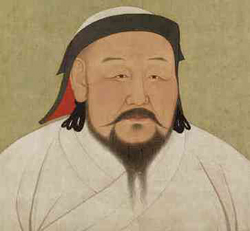
Khubilai Khan
Khubilai Khan, who had spear-headed the defeat of the Southern Song, founded a dynasty in China known as Yuan, and declared himself emperor. In order to keep the realm under control, he instituted a system of ethnic stratification that put Mongols of various origins at the top, other northern peoples such as the Uygurs and the surviving Tangut were in second place, while northern Chinese (who had a long history of interaction with the steppe people) were in the third position of trust, and the southern Chinese in the last. Many government and clerical positions were staffed with people from the northwest and Central Asia—especially Uygurs from the now Islamic areas of Xinjiang— who learned both Chinese and Mongolian. Most Chinese, especially in the rich Yangzi river valley were shut out of governmental appointments. Some scholars, like Guang Hanqing, released their creative energies by writing dramas, an art form that appealed to both the Chinese and their Mongol overlords.
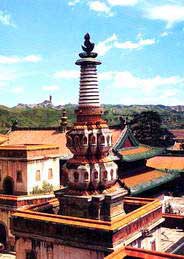
Summer Palace in Chengde
As the Yuan dynasty progressed the economy weakened as large amounts of wealth left China in the hands of foreign merchants who were allowed many advantages over their Chinese counterparts. Pressure was also put on peasants by Chinese gentry who had been allowed to keep their lands and by Mongols who were given tracts of land as part of the spoils of war. The government also needed tax revenues and corvee labor for massive public works projects, such as the overhaul of the old canal system, which was now needed to transport rice from the fertile south to the more barren north. A huge new capital was built – today known as Beijing. Even Beijing was too hot for the Mongol rulers, and a special summer palace (in Tibetan style) was built farther north in Chengde, near the old Mongol homelands. As the economic system weakened and some Mongols became disenchanted with a sedentary lifestyle, popular discontent grew. After about eighty years, ruling China became increasingly difficult. The Mongols were finally driven out by a peasant rebel named Zhu Yuanzhang, who had found common cause with the patriotic Chinese gentry. Zhu would become emperor of the Ming dynasty—the last Han Chinese dynasty in imperial history. Take a look at Inner Mongolia today.
Ming Dynasty (1368-1644)
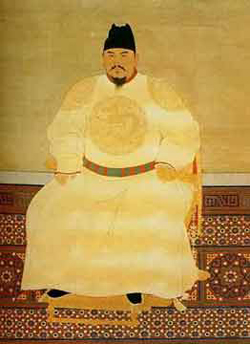
Zhu Yuanzhang
As noted, the Ming (“bright”) dynasty was the last imperial dynasty ruled by Han Chinese. Once Zhu Yuanzhang (also known by the reign name Hongwu) ousted the main Mongol forces, he declared himself emperor. He moved quickly to gain military control of the whole country, in many ways following Yuan styles of military and government organization. It was not until 1390, however, that the final Mongol holdouts were driven from southwest China. Occasional Mongol raids still perplexed the Ming even in the 16th century.
In order to re-staff and reinvigorate the government bureaucracy, Zhu revived the civil service examinations and set up government-sponsored schools throughout the land to help examinees ground themselves in the Confucian Classics. He also experimented with new tax policies by introducing a system by which local gentry were responsible for tax-collection in their local areas; farm households were organized in groups of ten with mutual responsibility for taxes and labor for public works projects.
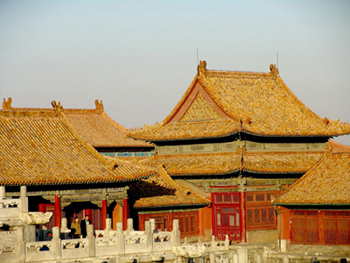
Forbidden City, Beijing
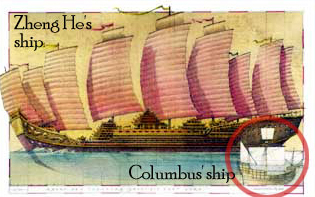
Zheng He's ship and Columbus' ship
His grandson, the Yongle Emperor moved the capital from Nanjing, in the south, to the site of the former Mongol capital, Beijing. Here, he built the massive Forbidden City between 1402 and 1421 that still stands beside Tian’anmen Square. Yongle also led a number of military expeditions into the remaining Mongol realms as a deterrent show of force. Besides re-furbishing the Grand Canal system to improve grain transport he commissioned the Moslem eunuch Zheng He on seven voyages across the Indian Ocean to the east coast of Africa and ports in the Arabian Sea. One detachment of his men actually made a pilgrimage to Mecca. Although the massive fleets of over 300 ships – including several huge treasure boats ten times the size of Columbus’ Santa Maria—must have inspired awe and respect in all who encountered them, for some reason Yongle lost trust in the enterprise (and Zheng He) and ordered the fleets burned. China thus lost its initiative as a commercial, sea-faring power. Years later in the dynasty, Japanese pirates would constantly raid the Chinese coast.
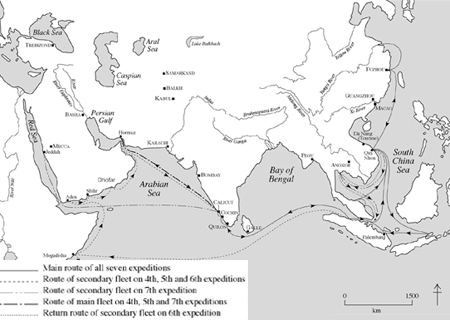
Zheng He's seven expedition routes
Other events marked a shift inward. The Mongols again proved a threat, actually capturing the reigning Ming emperor around 1448. The eventual result was a re-vamping of the Great Wall, which was initially formed from several existing walls and rebuilt and fortified along the borders of the northern steppe. Due to relatively stable times and advances in agricultural techniques, by 1600 the population had reached 150,000,000. New strains of hardier and faster-growing rice were developed and new crops such as the white potato, sweet potato, maize, peanuts, and hot peppers were arriving from the New World via the Portuguese, Dutch and other Europeans who were now taking control of the world’s sea routes.
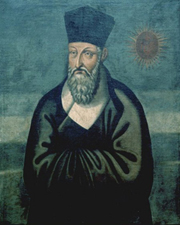
Jesuit Matteo Ricci, wearing Chinese scholar's clothes
Portuguese Jesuit priests (a highly learned sect of the Catholic Church) were the first sea-faring Europeans to arrive in China during the Ming, making contact in 1514. By 1582, the famous Jesuit Matteo Ricci, who (like Marco Polo in the Yuan dynasty) learned Chinese and even wore Chinese clothing. Chinese intellectuals shared knowledge of astronomy and invention with the Jesuits, who in turn introduced aspects of European mathematics and science of the day. Printing became even more widespread than in the past and a wide variety of books, including vernacular short stories and romances, found ready markets in urban areas.
Eventually the combination of a decline of leadership (coupled with corrupt eunuchs around the imperial court), a de-stabilization of the economy due to an influx of foreign silver, population growth, abusive tax policies, and popular rebellion weakened the Ming. Among the rebels was one Li Zicheng, who in 1644 managed to capture the father of a Chinese commander, Wu Sangui. Instead of submitting to Li Zicheng, Wu allied himself with Dorgon. Dorgon was a leader of the Manchus, a people who lived in the rich forests of Manchuria—what is now northeast China and part of North Korea. For several generations the Manchus, descendants of the old Jurched peoples, had been scheming to invade China under capable leaders such as Nurhaci (1559-1626). After Wu Sangui aided the Manchu forces in breaching the Great Wall they entered and soon took command of all China.
Part 7: From 1644 - Present
The Manchus established the Qing dynasty in 1644 AD, which lasted over two hundred and fifty years, far longer than the Mongol occupation. The Manchu empire extended China’s borders to their greatest extent in history, bringing allies such as Tibet and the northwest regions of Xinjiang under direct Chinese rule. Incredibly strong in its earlier years, the dynasty declined by the early 19th century from a combination of rapidly rising population, incompetent rulers, inner revolt, and outside forces that arrived by sea, rather than by the traditional land routes. In 1911-12 the dynasty collapsed, replaced by China’s first attempt at setting up a Western-inspired republican government.
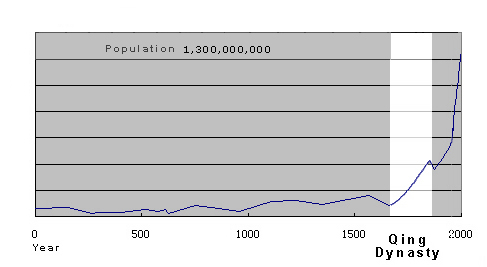
Population growth in Qing Dynasty
For generations before the takeover, Manchu leaders, such as Nurhaci and Abadi, studied Chinese culture and history in preparation for their invasion. Related to the populations of the ancient Jin state, the Manchu "banners," as they called their military units (in Mongol tradition), were composed of Manchus, Mongols, mercenary Chinese, Koreans, and other ethnic groups. Once the Manchus took hold of power, they instituted a system that kept much of the Ming system of rule intact and allowed many Chinese to continue to serve in office. Eventually a dual administration system was developed, with both Chinese and Manchu filling complementary government positions (something like the dual nature of the Communist Party and People’s government today). In many cases, local order was kept by the Chinese gentry.
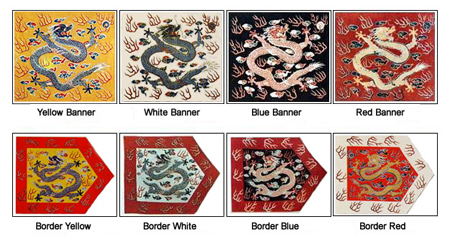
Manchurian Eight Banners of Qing Dynasty
All imperial documents were written in both Chinese and Manchu, though as the years passed, Chinese became the de facto court language. Nevertheless, attempts were made to preserve Manchu culture. Immigration into the Manchu heartland was at first forbidden, males in the realm were required to shave the front of their heads and grow a long, plaited queue, new dress styles demanded that garments fasten from the side, and Manchu women were forbidden to adopt the Chinese fashion of foot-binding (in which long cloth tapes were wound around a young woman’s feet in order to shape them into small “golden lotuses”.) Instead, upper-class Manchu women wore high platform shoes and distinct, elaborate headdresses.
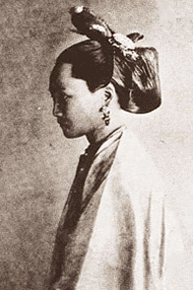
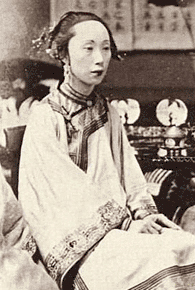
Manchu women's clothing and hair styles
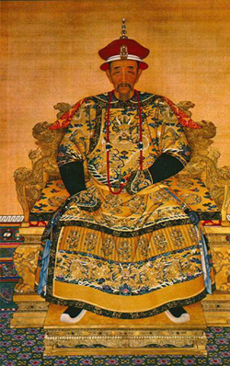
Emperor Kangxi
Two early Manchu emperors brought the Qing dynasty to its peak. These rulers were Kangxi and his grandson, Qianlong. Kangxi ruled for 55 years (1667-1722) during a time of great expansion. Qianlong left the throne after a reign of sixty years, a few years before his death. Under Qianlong the borders of China grew to their largest in history. Much of the expansion into lands on the northern and western borders seem to have been made to create buffers from perceived threats of overland invasion. Culturally, the Qing strongly censored historical and literary accounts for any anti-Manchu sentiments or romances such as Outlaws of the Marsh that might incite anti-government sentiment. On the other hand, Kangxi authorized the creation of a comprehensive dictionary, encyclopedias of knowledge, and huge compendiums of ancient writings. European learning continued to be introduced into China, including Western methods of painting employing perspective. In the eighteenth and nineteenth century a number of great works of fiction were produced, as well as large numbers of plays. In all, the reigns of Kangxi and Qianlong were times of intense activity among the intellectual class, which included Han Chinese and increasing numbers of Manchus raised in the traditions of the scholar-officials.
By the late 18th century, however, there were signs of decline, signaled by an uprising in Shandong of the White Lotus Sect, a Buddhist-inspired underground organization that had previously been involved in rebellions. Abuses by local officials seem to have been the cause. As Qing leadership waned in the early 19th century, the population was outgrowing the means to sustain itself and rebellions occurred. Large numbers of people, especially in the newly-settled southwest, were living on very marginal land. This was due in part to the earlier introduction of crops like sweet potatoes and tobacco that could be grown in poor soil.
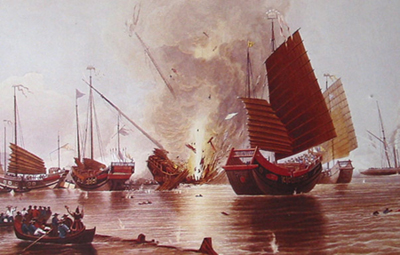
The Opium War
Trade frictions grew with the European powers, especially Britain. British merchants had long sought to right trade imbalances with China – the Chinese had little need for anything more than silver from the West, selling porcelain, silk, and tea in return. Eventually the British began illegally importing Indian opium into China, with the help of corrupt Chinese middlemen in specially designated coastal trade zones. When the Qing government moved to halt the illegal trade by burning confiscated opium, British traders petitioned their government for redress. British gunboats fired on Chinese positions along the coast, out-gunning the crude Qing cannon. The result of this so-called Opium War (1839-1842) was humiliation for the Qing government and a series of unequal treaties, including the Treaty of Nanjing that ceded the port of Hong Kong to the British in 1842.
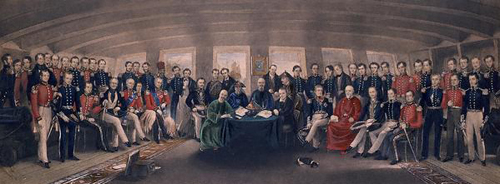
August 29, 1842, signing the Treaty of Nanjing
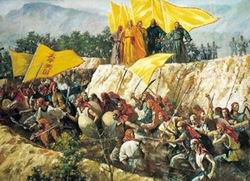
Taiping Rebellion
While foreign influence began to grow on Chinese soil, internal pressures mounted, finally erupting in the devastating Taiping Rebellion that raged from the early 1850s until 1864, leaving an estimated 30 million dead in its wake. The rebellion began in the southern province of Guangxi, and was led by a visionary of Hakka ethnicity named Hong Xiuquan. After failing at the local civil service examinations, Hong studied with foreign missionaries. He had a vision that pronounced him the younger brother of Jesus Christ, who was sent to earth to create a kingdom of “great peace.” Disenchanted peasants of several southern ethnic groups pledged themselves to his cause, giving up their property (which was then fairly redistributed), as well as opium, tobacco, alcoholic beverages, gambling, prostitution, polygamy, and foot-binding. Men and women were equal in the movement and soldiers lived a communal lifestyle. It is interesting that the grandfathers of several of the later Communist revolutionaries of the early twentieth century were Taiping rebels. As the movement grew in force it swept through southern China and nearly took the southern capital of Nanjing. The rebellion was weakened by contradictions among the Taiping leadership. Qing government forces, now partially Westernized in military hardware and tactics (though still behind Japan), finally put down the rebels with the help of European soldiers.
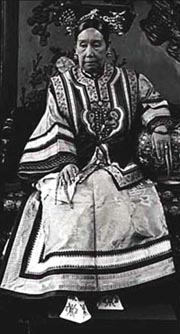
Empress Dowager Cixi in formal Manchu dress (note the platform shoes)
By the end of the 19th century it was becoming clear to many in China that serious changes must be made in order to save Chinese sovereignty in the face of aggressive European—and eventually Japanese—imperialists. Although a “self-strengthening movement” had some success in military reform, the reforms were hindered by weak imperial leadership. By the end of 1890s the imperial throne was under the influence of a former concubine known as the Empress Dowager Cixi. In response to foreign naval threats, she squandered funds on a large marble pleasure boat, now a tourist attraction at the Summer Palace in Beijing. After losing the Sino-Japanese War of 1894-95 (fought over control of Korea), it became clear to all that Chinese power was little more than a shadow of the past. Reformers, including Kang Youwei, finally convinced the imperial government to institute experimental reforms in government and military in the spirit of the reforms that had all too clearly yielded results in the Meiji Reformation in Japan. The “One Hundred Days of Reform” (named for how long the reform lasted) were too much of a threat to the conservative imperial order, and its leaders were either beheaded or fled to Japan.
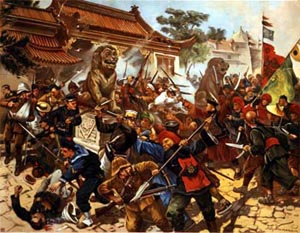
Boxers fighting with European and American armies
Things soon went from bad to worse. Another massive uprising, caused by famine and unstable social conditions, erupted in Shandong, in northern China. This movement was led by the so-called Righteous Order of Harmonious Raised Fists (Boxers, for short). The Boxers, who included de-mobilized soldiers, went on an anti-foreign rampage in 1898. A number of foreigners were killed, and armies of seven European countries and the United States fought off Boxer attacks throughout northern China. In the melee the imperial library was looted and huge amounts of treasure and antiquities were taken from China by foreigners, who ironically demanded indemnities for their own losses. More pressure was brought to bear on Chinese territory, and a fierce battle between Russia and Japan (which won) was fought in 1904-1905 for territories in northeast China.
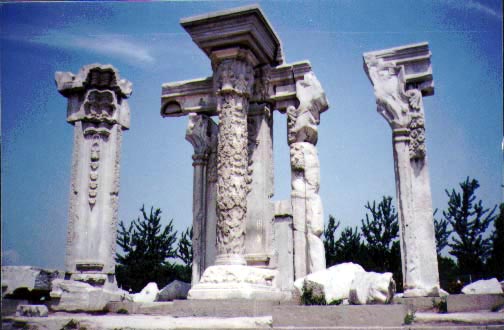
The Yuanming Yuan Garden was destroyed by foreign troops in 1900

Sun Yat-sen
By 1905, the imperial system was in a state of near-collapse—the civil service examinations were abolished in that year. Reform and revolutionary movements were rising both within and outside of China, with many young revolutionaries under the influence of ideas they had learned in Japan and the West. Among these was Dr. Sun Yat-sen, who helped organize the revolutionaries that eventually ignited a rebellion in the city of Wuhan in the Yangzi Valley. Although Sun was outside China at the time, he soon returned and was elected as president of the newly declared Republic of China—a modern-style, Western-inspired government that was supported by a variety of social classes that all wished to see the Qing come to an end. Within a month, however, Sun stepped aside and Yuan Shikai, head of the Beijing military, was elected as president. The new government was unable to take control of the whole country, and local military governors began assembling their own spheres of influence. By 1915 Yuan Shikai declared himself emperor, but died a few months later. Other leaders followed, but could not stop the growth of warlord states that set up local power bases much as small states arose after the collapse of earlier dynasties. Sun Yat-sen founded an opposition government in southern China supported by his followers, the Nationalist Party.

An oil painting of May Fourth Movement, 1919
By 1919, following ill-treatment of China under the Treaty of Versailles that ended WWI, a movement arose among students and intellectuals at the new Beijing University. This so-called May Fourth Movement was an intellectual and spiritual revival among educated, urban Chinese already exposed to many Western ideas and technology. Protests marches were held—and some students were shot by government soldiers. The students called for reforms in government, science, and culture—all similar to modernizations made in Japan over fifty years before.
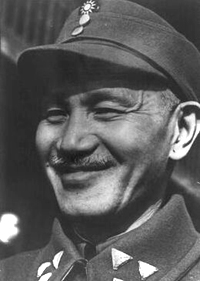
Chiang Kai-shek (Jiang Jieshi)
After the death of Sun Yat-sen in 1925, Chiang Kai-shek (Jiang Jieshi), a young military man who had received training in the Soviet Union, took control of the Nationalist Party. He quickly moved against the warlords on the Northern Expedition in 1927, and was quite successful in gaining control of parts of eastern China. His efforts were complicated, however, by the rise of the Chinese Communist Party, founded in 1921 by a handful of young revolutionaries inspired by the success of the of the Soviet Union, founded in 1917. Pushed underground by the Nationalists, the Communists retreated to mountain lairs in southern China, where they perfected their reform movement in neglected peasant areas.
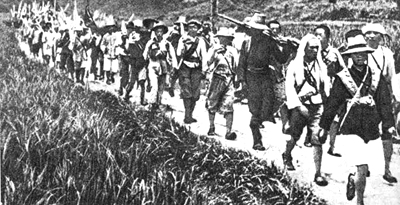
Red Army soldiers on the Long March
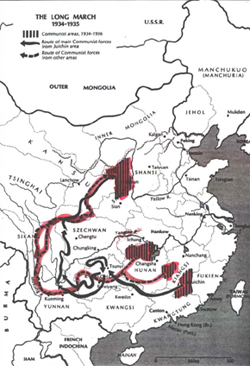
5,000 mile-Long March
By the late 1920s, the Japanese were threatening northeast China, where they set up a puppet-state in old Manchuria. A prolonged movement against the Communist strongholds by Nationalists in 1934 caused the Communists to pick up and walk 5,000 miles through the extreme terrains of southwest and western China. The Long March took over a year and only 20,000 of the original 100,000 participants survived the march, which ended in a place called Yan’an in the mountains of Shanxi province, not far from the ancient Qin capital of Xi’an. Among the marchers were the eventual founders of the People’s Republic of China in 1949: Mao Zedong, Zhu De, Zhou Enlai, and Deng Xiaoping. For a time in 1936, there was talk of a united front of Nationalists and Communists against the Japanese. In the so-called the Xi’an Incident Nationalist generals Zhang Xueliang and Yang Hucheng, with the support of the Communist leader Zhou Enlai, kidnapped Chiang Kai-shek and forced him to join a united front with the Communists against the Japanese. This united effort, however, eventually fell through.

Live victims were used by Japanese soldiers for bayonet practice in Nanjing
By 1937, the Japanese had invaded deep into China, bombing Shanghai and committing horrendous atrocities on the population of Nanjing. The Nationalist government, wracked by corruption and lacking in resolve, lost many troops in battles trying to protect the coastal cities. The government eventually retreated inland up the Yangzi River, finally creating a base in Chongqing, Sichuan province. Meanwhile, the Communists, from their base in Yan’an spread their influence among peasants across northern China and penetrated behind Japanese lines using sophisticated guerilla warfare tactics.
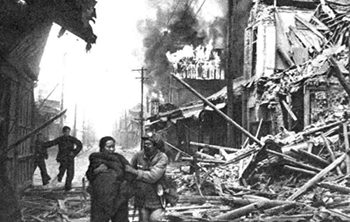
China during civil war: a Red Army man helping refugees
As the Anti-Japanese War (1936-1945)—what the Chinese call WWII—was drawing to an end, the United States, which supported the Nationalist cause briefly entertained the idea of a coalition government between Communists and Nationalists, and even sent a mission to Yan’an in 1944. Once the war was over in 1945, however, the US aided the Nationalists by helping them move troops to northeast China to accept the Japanese surrender, and check the advancing Russians who were interested in regaining ports and railway lines in Manchuria. Despite US support of the Nationalists, the Communist following (due in part to the common cause they had with the peasants in resisting Japan) was strong enough that they eventually won the civil war and drove Chiang Kai-shek and the Nationalists to the island of Taiwan, which had been under Japanese control for over eighty years. In October 1949, Mao Zedong stood on the terrace in front of the Forbidden City in Beijing and declared the founding of the People’s Republic of China.

Mao Zedong announcing the creation of the P.R.C. on October 1, 1949
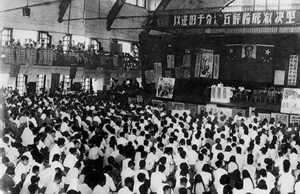
Anti-Rightist campaign, 1957
The early years of the People’s Republic saw land reforms and steps toward feeding, housing, and providing medical care to an estimated 400 million people in a country ravaged by over a century of almost constant war and rebellion. Mao Zedong, the major thinker behind the Communist revolution, was made Chairman of the Communist Party. By the late 1950s, questions began to arise among intellectuals and common people alike over certain of Mao’s policies, which were also challenged by some other Party leaders. In 1957, the government asked for constructive criticisms on its policies in a political movement known as the Hundred Flowers Campaign. The criticisms were more than Mao had gambled on and he soon launched a counter-revolutionary movement called the Anti-Rightist campaign, which resulted in the stigmatizing or imprisonment of many intellectuals and students who had offered even the most innocent suggestions.
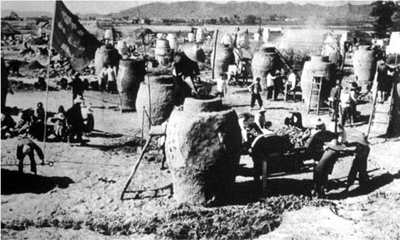
Great Leap Forward: melting down metal objects for steel
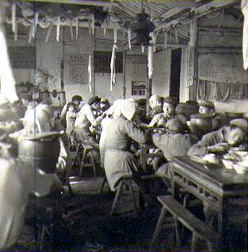
Communal dining hall during the Great Leap
This began a prolonged era of periodic, government induced political movements that wracked and divided Chinese society into the late 1970s, with occasional repercussions as late as the 1980s. In 1958, in response to inner-party criticisms of the Anti-Rightist campaign—which some moderate Communists thought had gone too far, Mao launched a movement called the Great Leap Forward. During this period, Mao cut relations with the Soviet Union, which had been supplying technical support to China since 1949. Throughout the country over 700,000 People’s Communes were created in a furthering of land reforms already instituted in the early 1950s. Communal housing and kitchens were set up all over and the populace was burdened with the task of melting down any metal objects they could lay their hands on in homemade smelters in order to help China raise its steel production to that of Britain within five years. Needless to say, this project failed – China was not going to rapidly overtake the developed countries, regardless of an initial wave of Socialist zeal over the project. Since everyone was involved in steel production, harvests failed and by 1961 over 30 million people (Chinese statistics!) had starved, many in areas where local officials had inflated grain production figures that were reported to a bean-counting government.
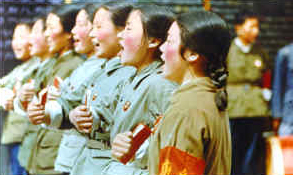
Young Red Guards singing in praise of Chairman Mao
By 1963, Mao had been skillfully shunted aside by Liu Shaoqi and Deng Xiaoping, leaders who suggested that experiments with basic capitalist production might be useful for development. Within a few years, however, Mao had rallied his many allies, and began a movement that indoctrinated the young people of China to believe that they were the vanguard in a new movement against counter-revolutionaries in the schools and government offices. This was the Great Proletarian Cultural Revolution.
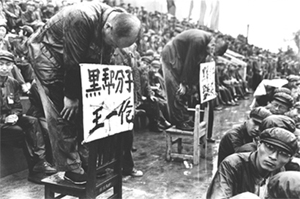
Many were publically criticized in the Cultural Revolution
By 1966, huge rallies of young Red Guards were trekking (sometimes over a thousand miles) or riding free trains to massive rallies in Tianan’men Square in Beijing in hopes of glimpsing Chairman Mao as he spoke to them. Violence broke out as Red Guard groups “struggled” against “reactionary” teachers and officials – some of whom were beaten to death by over-zealous students, or committed suicide out of shame after public rallies in which degrading signs were hung around their necks and pointed dunce caps placed on their heads.
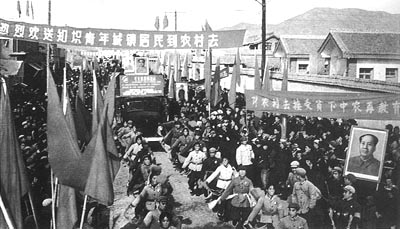
Parades were held to send off urban young people to rural areas
By 1968, the Red Guard movement was out of control and factions fought among themselves to prove their loyalty to Mao. Eventually the Red Army interceded, and large numbers of students and urban youths were sent to rural areas to “learn from the peasants.” Life on the communes was not easy for many city youths and older counter-revolutionary intellectuals. The peasants, who often had no clear idea of what was going on in the cities, often resented the sudden arrival of groups of city-raised young people.

Nixon meeting Zhou Enlai, 1972
By the early 1970s, a group called the “gang of four,” which included one of Mao’s wives, Jiang Qing, took control of the country as Mao aged. During the early 1970s, US President Richard Nixon and his aide, Henry Kissinger, began secret talks with the PRC leadership. These talks eventually led to a ping-pong match between Chinese and American athletes. Ultimately, in 1972, Nixon visited China, meeting with Premier Zhou Enlai (a respected diplomat who stayed the course through years of chaos), and a senile Chairman Mao.
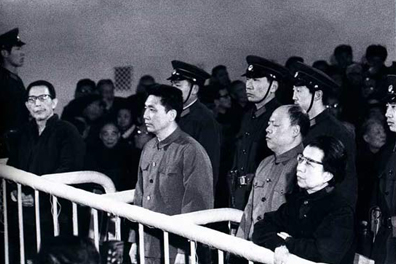
"gang of four" on trial, 1980
With Mao’s death in 1976 (the same year as the death of Zhou Enlai, Zhu De, and a terrible earthquake in Tangshan that killed 250,000 people) the Cultural Revolution came to an end with the capture of the “gang of four” by the Chinese army. By 1980, reformer Deng Xiaoping (who stood only 4’9”) used his political skills to come to power. Jailed three times by Mao, he was always considered a creative intellect, due in part to several years spent in France in his youth. By the early 1980s, Deng had systematically set China on a new course towards a more open, economically viable society. Abandoning radical Maoist ideas on communal economy, the new plan was to create “socialism with Chinese characteristics.” Although finding a new direction was sometimes difficult, in all the process was carried out in a very systematic way, combining socialist and previously taboo capitalist principles.
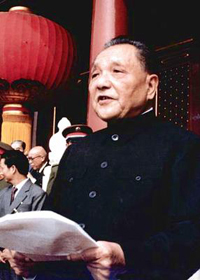
Deng Xiaoping
As a first step, the people’s communes were dissolved, and a “household responsibility” system was put in place in the rural areas. Now, instead of laboring for “work points” farmers could control what they raised and keep a large share of the profits. Land was re-divided under renewable contracts and sideline productions of animals, fruit, and other items were again allowed and encouraged. Once the rural economy was stimulated, more liberal policies were launched in the cities, and small private businesses staffed by “unemployed youths” with older advisers were encouraged. On a larger scale joint ventures were allowed between government companies in some coastal cities and foreign firms. An experimental capitalist city called Shenzhen was built near Hong Kong. Lessons learned there were later applied to other cities.
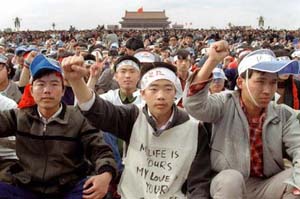
Tiananmen Square protests, 1989
Changes came fast and expectations rose faster. By the late 1980s, unrest developed among idealistic students on campuses in Beijing and Shanghai, with complaints of government corruption and calls for more democracy and a swifter pace of openness and modernization. By the spring of 1989, over 90 days of protests in Tian’anmen Square resulted in what the Chinese government considered a popular uprising in which a number of soldiers were killed and burned, stimulating a brutal response which resulted in the deaths of an unknown number of civilians, including some students.
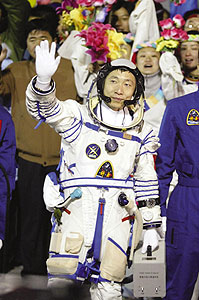
Yang Liwei, China's first "Taikonaut"
After several years of retrenchment, economic policies were reaffirmed in the spring of 1992 and China entered a stage of rapid economic growth. After Deng’s death in 1997, the reforms progressed even more rapidly, averaging 8-9% a year economic growth into the early 21st century. In the same year Hong Kong was returned to China and became a special administrative zone. A new area of Shanghai called Pudong marked Shanghai’s economic rebirth, more and more government companies became private, and foreign investment skyrocketed. This included participation by Japan and Taiwan (which had successfully modernized its economy by the early 1980s, instituting democratic reforms in the late 1980s). Stock markets were founded and became a passion for everyday citizens. Millions of peasants streamed into urban labor markets, forming a huge “floating population” of over 150 million temporary workers. New forms of popular culture spread throughout the land by television, a relatively liberalized film industry, and the Internet. Universities began charging tuition and some students took part-time jobs (unthinkable before the late 1980s). Health care became expensive, and declined, along with other social services like education, in some rural areas. A new optimism fueled by opportunity and intense competition ignited in young people across the nation. Corruption found new outlets in the dynamic economic environment. Despite enforcement (with some slackening) of the “one-child” birth control policy in force since the late 1970s, China’s population reached 1,300,000,000 by 2004. China joined the World Trade Organization in 2002 and became more integrated into the world economic scene. China’s first “taikonaut,” Yang Liwei orbited earth in 2003, and plans were soon announced for a future lunar mission. What the future holds for China remains to be seen, but will no doubt have worldwide repercussions.
View of the future: Pudong New District in Shanghai